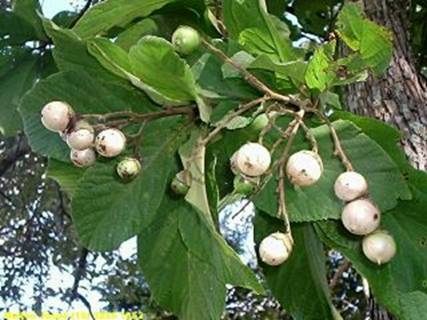CORDIA GRANDIFOLIA
POPULAR NAME: BABOSA DOCE, BABA DE BOI AND GUANHUMA AMY
BORAGINACEAE
|
|
|
RIPEN WHITE FRUITS |
INDIGENOUS NAME: Guanhuma, comes from the Tupi-Guarani and means "sticky fruit" because of the gelatinous and gummy aril.
Origin: Semideciduous forest (which lose their leaves in a time of year) of the Atlantic Rainforest from Minas Gerais to Paraná, at the borders of streams and wet woods. Brazil
Characteristics:
Tree with straight trunk
with greyish white bark and dense canopy.
The tree grows
Planted in the site of Frutas Raras: September 2003, blossomed in 2006, bear fruit in 2007.
Tips for planting: Tree of moderate growth with white flowers, ornamental, ideal for parks, reforestation and urban parks. Can be grown throughout the country, because resisting the frosts of up to -3°C (27°F), adjusting to any type of soil, which drain the rain water or even clay soils, exposed by flooding on the edge of rivers.
Propagation: The
seeds are hard and lose their germinative power in 6 months,
they germinate when
planted immediately in
Planting:
Can be planted in full
sun or mixed for use in reforestation of timber and fruit to feed various
birds. In the garden is to plant in one space of 6 x
Cultivating: Make
only form pruning of the crown and remove branches that were grown from the
base of the trunk, if you want to grow the tree or if you prefer to produce
a rounded crown, can let the terminal bud when the plant is under
Uses: The ripen fruits acquire the white coloring to stern and clear, sticky sweet and acidulated. The fruit can be consumed in-kind and used to make brew of great taste.
Flowering in the site of Frutas Raras: November to January.
Fruiting in the site of Frutas Raras: January to March.
BUY THE BOOK “COLECIONANDO FRUTAS”
Back to the seedlist (English) or back to Boraginaceae (Portugese)
